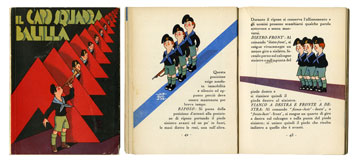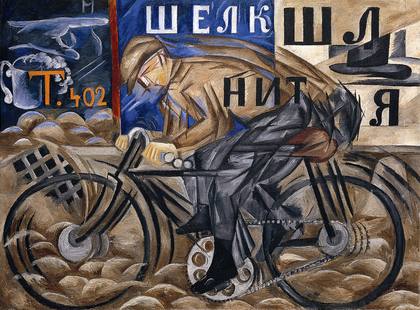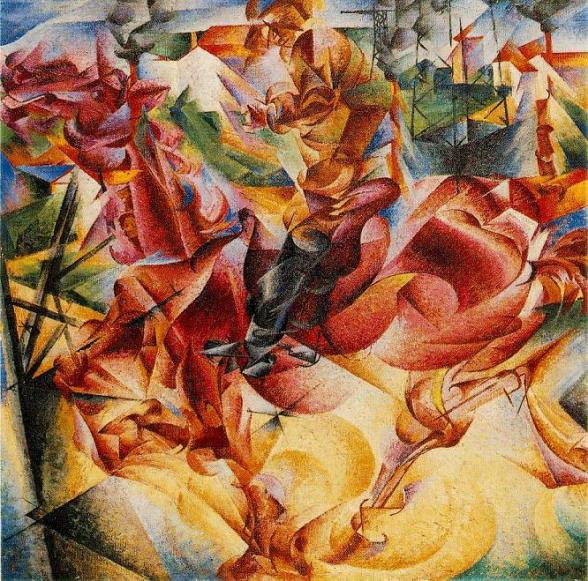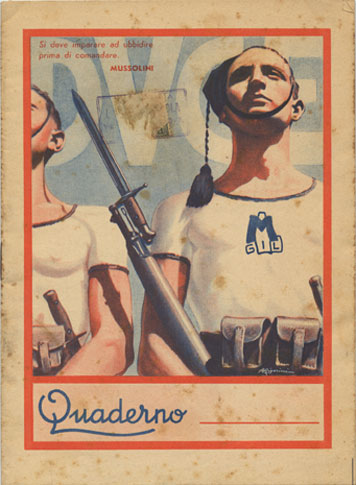In the parade scene of Fellini’s Amarcord,the director seems to surgically probe at the roots of Italian fascism. The evidence seems to indicate that even strong-armed fascism cannot control the id. In fact, its swollen and pussy ideology and exaggerated sense of self-importance seems to release recessed hormonal drives in which hero-worship is equated with sexual fantasy. The ideology seems to have all the ingredients of the sexual objectfication, the “male gaze” and the individual as fetish object and Fascisim as nothing more than a big show.

"Even a ritualistic fascist rally, complete with a giant Mussolini head made of flowers, is filmed with the same over-the-top energy and vitality, demonstrating how easily the townspeople's vibrant personalities could be absorbed by the Mussolini machine. The fascists provide an ugly underbelly to the film as a whole, especially in a chillingly underplayed scene in which they force a local socialist-sympathizer to drink castor oil, a common punishment doled out by Italian fascists." Read More: http://seul-le-cinema.blogspot.com/2007_09_01_archive.html image: http://flavors.me/perrindrumm#da8/wordpress
When the sought after village beauty catches sight of ludicrously huge floral Mussolini speaking head is is a metaphor for a fantasy wedding ceremony and she almost faints with sexual excitement. “In the following sequence, main character Titta’s (Bruno Zanin) family takes their “insane” Uncle Teo (Ciccio Ingrassia) from the asylum for a day excursion. Teo escapes, climbs a tree, and screams from the treetop, “I want a woman!” Without outlets for sexual drives, the townspeople go mad or displace their stifled desires onto political symbols manipulated by the regime.” Read More: http://www.sensesofcinema.com/2002/great-directors/fellini/
Filippo Marinetti asserted that Futurist art would act as an explosive device, a lightning rod in the upholding of a new set of values based on speed, destruction and the uses of violence as characterizing a new era and rebirth of Italian national grandeur.It was almost a sequel to Savonarola and the Bonfire of the vanities. It was to be messianic and harness latent religious reactionary tendencies to the new technological age. It was also nihilistic. In “The Founding Manisfesto of Futurism”, Marinetti exalted the glory of war as a cleansing process, “the world’s only hygiene”, a proclamation of a crisis that would make apparent the radical foundation of a new aesthetic world order with profound social and political consequences.

Steven Heller:Images portrayed individual young Fascists in sleek poses like statues poured from the same mold. The airbrush became an ideological tool in the making of myths. Fascist artists used the airbrush to streamline human figures into modernistic effigies and this mythic image of the Giovanili symbolized obedience and allegiance. In contrast to the stiff heroic realism of Nazi iconography, portrayals of Fascist youth involved futuristic nuance that reduced the human figure essentially to a sleek logo. The quintessential ONB member wearing short pants, black shirt, fez and crossed white breast straps looked more like a toy soldier than a hardened fighter; the helmeted Vanguardisti carrying a baton or dagger looked more menacing yet still resided in that netherworld between youth and adulthood. Read More: http://observatory.designobserver.com/entry.html?entry=6957
Futurism was an avant-gardist assault on the autonomous status of art in modern bourgeois society, that coincidentally emerged at the same time variations on the Aryan myth were being fabricated in northern Europe. For Marinetti it was a movement of both a destruction of art historical, and nascent democratic tradition; an emphasis on formal innovation that would characterize and throw ambiguity onto the modernist movement that still resonate today.
Walter Benjamin: The logical result of Fascism is the introduction of aesthetics into political life. The violation of the masses, whom Fascism, with its Führer cult, forces to their knees, has its counterpart in the violation of [a technological] apparatus which is pressed into production of ritual values . . . All efforts to render politics aesthetic culminate in one thing: war . . . Only war makes it possible to mobilize all of today’s technical resources while maintaining the property system.Read More: http://www.princeton.edu/~publicma/Weinbaum_article.pdf

Steven Heller:The mystique of youth was a fascist obsession. This obsession was played out through propaganda and built upon the manufactured youthful image of Il Duce (the media was prohibited from discussing his grandchildren but countless photographs of the bare-chested Mussolini were published in newspapers and magazines). The Duce also encouraged the creation of youth groups that emphasized sports and martial training in order that its members be fit enough to carry the baton of the Fascist movement into the future. Indeed the shock troops of Fascism were originally gangs of unbridled youth — a generation of combatants storming through Italy wearing black shirts, jackboots, carrying death’s head flags, and wielding batons against an enemy that represented social decay and cultural elitism....Read More:http://observatory.designobserver.com/entry.html?entry=6957
According to Benjamin, Fascism aestheticizes politics, using film and photography as required. Through “violation of an [technological] apparatus,” Fascism mobilizes the masses to maintain their own proletarianization and the prevailing property system. Fascist art (the example Benjamin gives is that of Italian Futurist, Franco Marinetti) supplies “gratification of a sense perception that has been changed by technology” to such an extreme degree that society “can experience its own destruction as an aesthetic pleasure of the first order.”Alternatively, liberatory cultural forms (those spawned by a critique of the prevailing property system) respond to changes in perception “by politicizing art.” In other words, Benjamin tightly binds human liberation to particular forms of artistic production. In his view, radical politics require art that reflects and refracts transformations in the mode of production and perception, and channels these changes into critical consciousness, which, for Benjamin, was tantamount to class consciousness. Read More: http://www.princeton.edu/~publicma/Weinbaum_article.pdf

Natalya Goncharova.1913. "The Futurists were contemptuous of all tradition, of all that is past: "We want to exult aggressive motion...we affirm that the magnificence of the world has been enriched by a new beauty: the beauty of speed." The machine was poetically eulogised. The racing car became the icon of the new epoch, "which seems to run as a machine gun". The Futurist aesthetic was to be joy in violence and war, as "the sole hygiene of the world*. Motion, dynamic energy, action, and heroism were the foundations of "the culture of the Futurist future. The fisticuffs, the sprint and the kick were expressions of culture. The Futurist Manifesto is as much a challenge to the political and social order as it is to the status quo in the arts. " Read More: http://www.oswaldmosley.com/filippo-marinetti.htm image:http://www.bbc.co.uk/radio4/features/front-row/galleries/futurism/index.shtml?gp=2
Alan Woods: Here we have the distilled essence of imperialism – the notion that wars are a necessary means whereby humanity overcomes stagnation and purifies itself through fire. This adequately conveys the delirium of the Italian imperialist petty bourgeoisie wh
eeted the horrors of the First World War as one would welcome the invitation to a party.Later on this dream of the Italian imperialist petty bourgeoisie turned into a nightmare. But in the years that preceded the great imperialist slaughter of 1914-18, it acted as the mainspring of the main trend of Italian art. From the beginning, futurist art was impregnated with a spirit of suppressed violence and aggression. Here in paint we see the concentrated expression of the pent-up rage and frustration of the Italian imperialist petty bourgeoisie. The slashing lines that criss-cross these abstract paintings are like the tracer bullets that light the sky over a battle at night-time. The jagged edges speak of lacerations. The whole thing is filled with an explosive element that anticipates war, upheaval and conflict.Read More: http://www.marxist.com/ArtAndLiterature-old/italian_futurism_and_fascism.html a

Luigi Russolo. 1911. Woods:In the beginning, the highly combustible mood that underlies this art could be mistaken for a revolutionary feeling, and in fact it reflects a revolutionary trend insofar (and only insofar) as it rejects the status quo. This art is a slap in the face for existing society, its aesthetic norms and values. It announces the immanent end all that is: it proclaims that all that present society regards as sacred and valuable is based on a rotten foundation. This foundation must be dynamited, blown sky high, in order that the creative spirit of the people should be liberated. What began as an artistic message - the rejection of stagnation and inertia in art - now becomes a clearly political message. Not just the old art, but all the other manifestations of the old society must be overthrown. In some ways the futurist point of view comes close to the ideas of Bakunin - the idea that before we can build a new society it is first necessary to destroy. Read More:http://www.marxist.com/ArtAndLiterature-old/italian_futurism_and_fascism.html image:http://www.bbc.co.uk/radio4/features/front-row/galleries/futurism/index.shtml?gp=6#gallery4673
PICKWICK EXTRA:
The alteration of human sense perception enabled by technologies of mechanical reproduction did not, however, produce a singular political effect. Rather, much to Benjamin’s dismay, the impact of changes in perception heralded by film and photography lay precariously in the balance. And thus, writing on the eve of World War II, Benjamin’s guiding political question had to do with whether the
work of art and new mode of perception that it enabled would be used to foment human oppression or liberation or, in the terms of his
day, fascism or communism….

Boccioni. Bolton: At the 1924 Futurist Congress, the delegates upheld Marinetti’s declaration: The Italian Futurists, more than ever devoted to ideas and art, far removed from politics, say to their old comrade Benito Mussolini, free yourself from parliament with one necessary and violent stroke. Restore to Fascism and Italy the marvelous, disinterested, bold, anti-socialist, anti-clerical, anti-monarchical spirit . . . Refuse to let monarchy suffocate the greatest, most brilliant and just Italy of tomorrow . . . Quell the clerical opposition . . . . With a steely and dynamic aristocracy of thought. In 1929, Marinetti accepted election to the Italian Academy, considering it important that “Futurism be represented” He was also elected secretary of the Fascist Writer’s Union and as such was the official representative for fascist culture. Futurism became a part of fascist cultural exhibitions and was utilized in the propaganda art of the regime. Read More: http://www.counter-currents.com/2010/10/filippo-marinetti/ image: http://www.keithgarrow.com/modern-art-styles/futurism-art-movement.html
On the one hand, when made infinitely reproducible and thus available for consumption by the masses, film
and photography possessed the potential to democratize society by making viewers into critics and giving them an experience of critical
and liberatory collectivity. On the other hand, film and photography and the sense perception they enabled were ripe for exploitation by
the fascist ideology machine eager to create a compliant mass, blind to its own exploitation.

"In the beginning, the highly combustible mood that underlies this art could be mistaken for a revolutionary feeling, and in fact it reflects a revolutionary trend insofar (and only insofar) as it rejects the status quo. This art is a slap in the face for existing society, its aesthetic norms and values. It announces the immanent end all that is: it proclaims that all that present society regards as sacred and valuable is based on a rotten foundation. This foundation must be dynamited, blown sky high, in order that the creative spirit of the people should be liberated. What began as an artistic message - the rejection of stagnation and inertia in art - now becomes a clearly political message." Read More: http://www.marxist.com/ArtAndLiterature-old/italian_futurism_and_fascism.html image: http://esposito.typepad.com/con_read/weekend_content/
Steven Heller:Nothing was more integral to Italian Fascist life than its youth. In 1923, Giovanni Gentile, the Education Minister and Fascist philosopher, conceived of a new educational system. This system was not intended to train youth to think for themselves, but rather, to turn them into instruments of the regime. In fact “the cult of the cradle,” as the fascist strategy was known, was an aggressive official doctrine determined to inculcate in predominantly male youngsters, the mythology of the omnipotent regime in order to transform so-called “flowers of faith” into soldiers of empire. Relentless propaganda campaigns and the “Fascistization” of schools and youth groups would breed a new cultural order. Read More: http://observatory.designobserver.com/entry.html?entry=6957 a

Heller:The Fascists worshiped might and celebrated speed, which was duly represented in modernistic graphics and typography. Antiquated, central-axis-page composition was replaced by more dynamic aesthetics that wed Futurism to Art Deco — controlled anarchy to decorative mannerism. Typefaces with sharp edges and contoured right angles expressing velocity, as well as a stencil lettering like Braggadocio (Bravado), replaced the classic Roman alphabets (at least in propaganda aimed at the young) considered old fashioned. Language drove the look of type and Mussolinian words like struggle, courage, death, glory, discipline, martyr and sacrifice were appropriately spelled out in letters that seemed to speak loudly and bombastically. Read More: http://observatory.designobserver.com/entry.html?entry=6957





 COMMENTS
COMMENTS